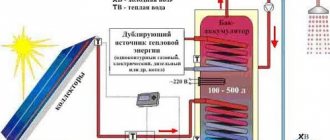People have always been looking for efficient fuels to heat their homes.
As technology has advanced, wood and coal stoves have been replaced by electric heaters and solar panels.
However, the operation of new devices was associated with large financial costs. As an alternative, some have begun using Brown's gas to heat their homes.
Use Brown's gas to heat your home
A little theory
It should be noted that the resonant decomposition of water into Brown gas is by no means a myth, but a real chemical process designed to release gaseous fuel from water. This gas gets its name from the inventor who first tried to take this technology beyond experimentation. Another name that appears on the Internet is detonating gas (hypothetical formula of NNO).
Brown's flammable gas is nothing more than a mixture of free hydrogen and oxygen released from water through an electrolytic reaction.
Water, whose chemical formula (H2O) is known even to children, is hydrogen, which is completely oxidized. Individually, these chemical elements are very active, hydrogen burns well and is considered an energy carrier, and oxygen supports combustion. That is why splitting water, whose price is just a penny, into such useful components has become a very popular idea.
As a result, through the efforts of various people, a generator for producing gas - an electrolyzer - was born. Without going deeply into the intricacies of the process, we note that the above-mentioned apparatus uses the electrolysis method to separate Brown's gas from water, or rather, a mixture of oxygen and hydrogen. To do this, a current of optimal frequency is passed through electrodes immersed in a container of water. The resulting gas accumulates under the water seal and, when a certain pressure is reached, exits through the tube and can be used for various purposes.
Obtaining gas from water
The main advantage of Brown's gas over all other coolants is its low cost. It is obtained from the most accessible and cheapest raw material - water. The hydrogen and oxygen included in its composition individually show high combustion efficiency. Therefore, the main task in obtaining gas is the separation of water molecules into atoms.
The splitting process is a chemical reaction that occurs under the influence of an electrolyte. To carry out such a reaction, a special apparatus was created - a Brown gas generator. Its design includes several parts:
- water tank;
- electrodes;
- gate;
- gas outlet tube.
In this video we will look at how to make a hydrogen generator with your own hands:
The operating circuit of the gas generator consists of two parts. The electrolyzer is responsible for the operation of the first part (chemical). The second - electrical - is provided through the generation of pulses.
This is interesting: types of electric heaters.
Generator operating principle
In fact, you can make a Brown gas generator for heating your home with your own hands, but this requires some skill and knowledge. In this case, you can use both purchased material and what is at hand. Such a device can be used not only for heating the house, but also for other purposes. The operating principle of the device is based on the decomposition of water in an electrolyzer, after which a gas is formed with a by-product in the form of water vapor.
The main advantages of the Brown generator include:
the material used for processing (ordinary water) is accessible and inexpensive;
- in the process of processing the liquid, condensate is produced, as a result of which the steam is converted into water, and the fuel is renewed at this time;
- homemade equipment is an environmentally friendly device, so it does not emit any harmful substances;
- in the room where the process is carried out, the air does not dry out, but, on the contrary, is humidified, since the device emits steam.
The manufacturing process of a heating installation is quite complicated for several reasons. The main one is the profitability of use. The fact is that the operation of the device requires an electrical network, so it is worth calculating in advance how profitable it is to use such a design.
Factory equipment is quite expensive, and you will also have to spend money on installation and subsequent maintenance. It is much cheaper to make a Brown gas generator with your own hands, using drawings and diagrams that can be found in large quantities on the Internet.
Mechanism of action
In the process of obtaining gas for heating, electrodes are lowered into a container filled with water, the role of which is played by plates or pipes made of alloy steel. They are then connected to a source of electricity.
The connection must be made taking into account that the potential of adjacent plates is opposite. Only under the condition of alternating positive and negative charges will the decomposition of a mixture of hydrogen and oxygen into individual molecules occur.
Electrical pulses are applied to the plates, and gas is produced. First, it enters the drying tank, then passes into the coolant supply circuit. The steam generated as a result of a chemical reaction is an environmentally friendly fuel for heating homes.
The Brown generator cannot operate on purified water, which has dielectric properties. To ensure the constant passage of electric current through the liquid, salt, soda or caustic potassium were previously added to it. The introduction of such impurities sharply increased the amount of current consumed, while simultaneously reducing the efficiency of the device to such a level that its use as a heat generator became unprofitable. The solution was to use a different design for a source of electrical impulses, including:
- 12 V power supply;
- rectifier with a current of 10 A;
- two resistors with a resistance of 10 and 2.2 kOhm;
- potentiometer with a resistance of 10 kOhm;
- transistor model 838 or 2n3055;
- two coils on a single body;
- capacitor with a capacity of 50 µF.
Make your own Brown Gas Generator
The numbers shown are approximate. When creating a generator, preliminary calculations should be made based on the size of the heated room and the parameters of the electrical network.
Generator benefits
The generator for producing Brown gas has a fairly simple device and a clear principle of operation. Despite this, its use provides a number of significant advantages:
- The water required for its operation is available in almost unlimited quantities.
- Gas production is waste-free. The condensate formed during the electrolysis process turns into a liquid, which serves as a raw material for the formation of a new portion of fuel.
- The released steam humidifies the air in the room.
- When water breaks down, no substances are formed that negatively affect human well-being.
A water generator will not be able to sufficiently provide heating for a large house, but it will serve as an effective addition to other heating devices.
A device that generates gas from water is used not only in home heating systems. It is successfully used to produce hydrogen automobile fuel and for metal welding . Some Western European enterprises that have implemented such devices in their production have been able to abandon filters and air purification systems, since the process of melting and welding metals has become safer and more environmentally friendly.
The only significant disadvantage of Brown gas production is high energy consumption. The amount of electricity consumed is several times greater than the amount of heat received. Currently, specialists are working to reduce costs and increase the efficiency of the generating device.
Heating options
Improved materials and technologies make it possible to equip the heating system in different ways, because the coolant can be:
- antifreeze;
- steam;
- water;
- gaseous substance.
The choice is quite extensive, so after familiarizing yourself with the pros and cons of each option, you can choose the best one for yourself. Brown's gas, for example, is also used today in heating systems. It is also known as green gas, oxyhydrogen or brown gas.
Application area
Today, an electrolyzer is as common a device as an acetylene generator or a plasma cutter. Initially, hydrogen generators were used by welders, since carrying a unit weighing only a few kilograms was much easier than moving huge oxygen and acetylene cylinders. At the same time, the high energy intensity of the units was not of decisive importance - everything was determined by convenience and practicality. In recent years, the use of Brown's gas has gone beyond the usual concepts of hydrogen as a fuel for gas welding machines. In the future, the possibilities of the technology are very wide, since the use of HHO has many advantages.
- Reducing fuel consumption in vehicles. Existing automotive hydrogen generators allow the use of HHO as an additive to traditional gasoline, diesel or gas. Due to more complete combustion of the fuel mixture, a 20–25% reduction in hydrocarbon consumption can be achieved.
- Fuel savings at thermal power plants using gas, coal or fuel oil.
- Reducing toxicity and increasing the efficiency of old boiler houses.
- Multiple reductions in the cost of heating residential buildings due to the complete or partial replacement of traditional fuels with Brown gas.
- Using portable HHO production units for domestic needs - cooking, obtaining warm water, etc.
- Development of fundamentally new, powerful and environmentally friendly power plants.
We recommend: How to clean chimneys in a furnace using folk remedies: how to clean a pipe
A hydrogen generator built using S. Meyer’s “Water Fuel Cell Technology” (that’s what his treatise was called) can be bought - many companies in the USA, China, are engaged in their production. Bulgaria and other countries. We propose to make a hydrogen generator yourself.
conclusions
Today it is difficult to say which of the promising energy technologies will “shoot” in the future, when hydrocarbon reserves run out. Will it be thermonuclear fusion, solar or gravitational systems, hydrogen energy? So far, the evolutionary development of promising directions is underway and revolutionary breakthroughs are not expected in this area in the near future, no matter what the “yellow” Internet writes about. According to experts, the emergence of hydrogen electrolysis reactors, which could be a real competitor to traditional fuels, is expected no earlier than in 20-30 years. Many experts are generally skeptical about the prospects of hydrogen energy, leaving this type of fuel only a narrow niche in rocket science. But everyone who is involved in this business professionally agrees that truly efficient hydrogen reactors will be a product of high technology, and not “devices” assembled from old pots and other unnecessary pieces of hardware.
(no votes yet)
How to get hydrogen at home?
On the Internet you can easily find drawings and diagrams of a wide variety of homemade installations that allow you to extract Brown's gas from water. If you filter out the information garbage related to this topic, it turns out that you can get hydrogen at home in two ways. The first is to purchase a ready-made electrolyzer; these are already commercially available. One problem is that their price is too high, and the efficiency is unknown.
When buying a hydrogen generator, you need to understand that it will not be a panacea for you in terms of heating. The price of equipment and consumed electricity will be higher than simple electric heating of water, so there is no talk of payback.
As an experiment, you can make a Brown gas generator with your own hands, which allows you to release a small amount of fuel. It is unlikely to be used to heat a building, but it may well be enough to power a small burner for melting metal. First, you need to make an electrolyzer, which is a container of water in which the electrodes are immersed. The larger the surface area of the electrodes, the higher the productivity of the installation. Steel plates of arbitrary size attached to a dielectric base are suitable. The working diagram of the device is shown in the figure:
The electrodes are lowered into a hermetically sealed container of water, where ordinary salt is added to improve the reaction. A gas tube comes out through the lid and goes into the second vessel, which is a water seal; it is filled 2/3 with water.
The second tube coming out of this container is connected to the burner. It is better to supply voltage to the electrodes using an autotransformer, monitoring its value with a multimeter. How to assemble a Brown mini-gas generator with your own hands is shown in the video:
Attention! If you have managed to achieve any significant installation performance, the burner should be connected to the tube through a check valve to avoid backlash and explosion.
Homemade device
If you wish, you can learn how to produce Brown's gas yourself. It is not difficult to make a device for its production with your own hands. To do this, you need to use stainless steel plates, which should be cut into rectangles. In each sheet, at a distance of 3 cm from the edge, you need to make holes about 50 mm in size and solder the electrical cable.
Next, you will need to prepare two square plates of plexiglass measuring 20x20 cm (3 cm thick) and several rubber rings, the outer diameter of which will also be 20 cm. Mounting holes should be provided in the metal and glass sheets.
When all parts of the structure are ready, you can proceed to assembling the device. Between the two steel plates it is necessary to place a rubber ring, pre-treated with a sealing compound, and secure everything with bolts. To the two sides of the resulting part you need to attach sheets of plexiglass with holes for water inlet and gas outlet. Tubes and fittings should be inserted into them.
In a homemade generator, you must make two water jams, otherwise the resulting gas will begin to move in the opposite direction, which will lead to an explosion of the device. The tubes must be positioned so that one is completely immersed in water, and the second is above the liquid level and directed towards the burner. During the decomposition of the liquid, the resulting gas will move through them to water jams.
In order for the efficiency of a home-made heating device to be sufficient to heat a home, it must be used correctly. It is better to use distilled water and sodium hydroxide as starting materials. Before starting the device, apply a soap solution to the plates and then wipe them with alcohol.
During electrolysis, sediment will form on the walls of the generator and electrodes. The best way to remove it is with sandpaper.
Tips for assembling and operating a generator
Having solved the issue with the boiler, choose a suitable diagram and instructions on how to make a hydrogen generator for heating a private house.
A homemade device will be effective only if
:
- sufficient surface area of the plate electrodes;
- correct choice of material for the manufacture of electrodes;
- high quality liquid for electrolysis.
What size should be the unit that generates hydrogen in sufficient quantities to heat a house will have to be determined “by eye” (based on other people’s experience), or by first assembling a small installation. The second option is more practical - it will allow you to understand whether it is worth spending money and time on installing a full-fledged generator.
Rare metals are ideally used as electrodes, but this is too expensive for a home unit. It is recommended to choose stainless steel plates, preferably ferromagnetic.
Hydrogen generator design
There are certain requirements for water quality. It should not contain mechanical impurities and heavy metals. The generator operates most efficiently on distilled water, but to reduce the cost of design, you can limit yourself to filters to purify water from unnecessary impurities. To make the electrical reaction more intense, sodium hydroxide is added to the water in a ratio of 1 tablespoon per 10 liters of water.
Compliance with safety measures
The electrolyzer is a high-risk device.
Therefore, during its manufacture, installation and operation, it is imperative to observe both general and special safety measures.
We recommend: Heating equipment for the home
Special measures include the following:
- the concentration of the mixture of hydrogen and oxygen should be controlled in order to prevent an explosion;
- if the liquid level is not visible in the inspection window of the hydrogen generator, then it cannot be used;
- When performing repairs, you need to make sure that there is no hydrogen at the end point of the system;
- the use of open fire, electric heating devices and portable lamps with a voltage of more than 12 volts near the electrolyzer is contraindicated;
- When working with electrolyte, you should protect yourself by using protective equipment (overall clothing, gloves and goggles).
Water seal and fuse:
Pay your attention to figure No. 1 - there are two containers (I labeled them A and B), and a needle from a disposable syringe (B), all of this is connected by tubes from droppers.
You need to pour water into the first container (A), this is a water seal. It is necessary so that the explosion does not reach the electrolyzer (if it explodes, it will be like a fragmentation grenade).
Figure No. 5 – Water seal
Please note that there are two connectors in the water seal cover (I adapted all this from a medical dropper), both of them are hermetically glued into the cover using epoxy glue. One tube is long, through which hydrogen from the generator should flow under the water, gurgle, and through the second hole go through the tube to the fuse (B).
Figure No. 6 – Fuse
You can pour both water (for greater reliability) and alcohol (alcohol vapor increases the combustion temperature of the flame) into a container with a fuse.
The fuse itself is made like this: You need to make a hole in the lid with a diameter of 15 mm, and holes for the screws.
Figure No. 7 - What the holes in the lid look like
You will also need two thick washers (if necessary, you need to expand the inner diameter of the washer using a round file), two plumbing gaskets and chocolate foil or an ordinary balloon.
Figure No. 8 – Sketch of a safety valve
It is assembled quite simply; you need to drill four coaxial holes in the iron washers, lid and gaskets. First you need to solder the bolts to the top washer; this can easily be done using a powerful soldering iron and active flux.
Figure No. 9 – Washer with screws Figure No. 10 – Screws soldered to the washer
After you have soldered the screws, you need to put one rubber gasket on the washer and your valve itself. I used a thin elastic band from a burst balloon (this is much more convenient than putting on thin foil), although foil also fits quite well, at least when I tested my hydrogen torch for explosiveness, there was foil in the valve.
Figure No. 11 – Putting on the gasket and protective elastic band
Then we put on the second gasket and you can insert the protection into the holes made in the cover.
Figure No. 12 – Finished valve Figure No. 13 – Protection elements
The second washer and nuts are needed to tightly and firmly fix the protection by tightening the nuts (look at Figure No. 6).
Please understand and take note that safety rules must not be neglected, especially when working with explosive gases. And such a simple device can save you from unpleasant surprises. The protection works according to the principle “where it’s thin, it breaks”; an explosion knocks out the protective film (foil or rubber band), and the explosive force does not go into the electrolyzer; moreover, the water seal also prevents this. Take my word for it, if the electrolyzer explodes, you won’t think it’s enough :)!!!
Selected points of use
First of all, I would like to note that the traditional method of burning natural gas or propane is not suitable in our case, since the combustion temperature of HHO is more than three times higher than that of hydrocarbons. As you yourself understand, structural steel will not withstand this temperature for long. Stanley Meyer himself recommended using a burner of an unusual design, the diagram of which is given below.
Scheme of a hydrogen burner designed by S. Meyer
The whole trick of this device is that HHO (indicated by the number 72 in the diagram) passes into the combustion chamber through valve 35. The burning hydrogen mixture rises through channel 63 and simultaneously carries out the ejection process, entraining outside air through adjustable openings 13 and 70. Under the hood 40, a certain amount of combustion products (water vapor) is retained, which enters the combustion column through channel 45 and mixes with the burning gas. This allows you to reduce the combustion temperature several times.
The second point that I would like to draw your attention to is the liquid that should be poured into the installation. It is best to use prepared water that does not contain heavy metal salts. The ideal option is distillate, which can be purchased at any auto store or pharmacy. For successful operation of the electrolyzer, potassium hydroxide KOH is added to the water, at the rate of approximately one tablespoon of powder per bucket of water.
During operation of the installation, it is important not to overheat the generator. When the temperature rises to 65 degrees Celsius or more, the electrodes of the device will become contaminated with reaction byproducts, which will reduce the productivity of the electrolyzer. If this does happen, then the hydrogen cell will have to be disassembled and the deposits removed using sandpaper.
And the third thing we place special emphasis on is safety. Remember that it was not by chance that the mixture of hydrogen and oxygen was called explosive. HHO is a hazardous chemical that can cause an explosion if not handled properly. Follow safety rules and be especially careful when experimenting with hydrogen. Only in this case, the “brick” that our Universe consists of will bring warmth and comfort to your home.
We hope you found this article a source of inspiration and will roll up your sleeves and start making a hydrogen fuel cell. Of course, all our calculations are not the ultimate truth, however, they can be used to create a working model of a hydrogen generator. If you want to completely switch to this type of heating, then the issue will have to be studied in more detail. Perhaps your installation will become the cornerstone, thanks to which the redistribution of energy markets will end, and cheap and environmentally friendly heat will enter every home.
Unfold[ | ]
Line reel of a color picture tube. This form of coils is necessary to maintain convergence of the beams at the edges of the screen. To create an image on the screen, the electron beam must constantly pass across the screen at a high frequency - at least 25 times per second. This process is called unwrapping
. There are several ways to scan an image.
Raster scan
The electron beam passes the entire screen in rows. There are two options:
- 1—2—3—4—5—… (interlaced scanning);
- 1—3—5—7—…, then 2—4—6—8—… (interlaced).
Scanning on the radar screen
The first radars used an all-round indicator (“circular marker”), where the electron beam passes along the radii of a circular screen. Service information (numbers, letters, topographical signs) is either displayed using a vector method, or is additionally expanded through a sign matrix (located in an electron beam gun).
- Television raster, interline scanning
- TV raster, interlaced scanning
- Vector image scanning method
Hydrogen generator maintenance
The equipment must be carefully maintained. Experts advise adhering to the following tips:
- do not improve or change the generator yourself, even if you have a professional engineering drawing;
- it is recommended to install special temperature sensors inside the heat exchanger on the equipment, which will make it possible to control the process of water overheating;
- shut-off valves can be installed in the burner and connected to a temperature sensor. This will allow the device to cool properly.
A homemade generator allows you to produce hydrogen, but it is used mainly for experiments and gas welding. To heat a large building, the efficiency of the device is simply not enough. And at the same time, we should not forget about the low efficiency of the device, as well as the hassle and expense of assembling it.
Safety precautions and operating features
A hydrogen heating boiler must be operated correctly.
When using it, adhere to the following rules:
- You cannot upgrade or modify hydrogen heating equipment yourself. This increases the likelihood of hydrogen leakage. When it interacts with air, an explosive situation is created.
- Install temperature sensors inside the heat exchanger. This will allow you to control the degree of water heating. Check the temperature periodically to ensure that the coolant does not overheat.
- Do not operate heating equipment in modes and conditions that are not provided by the manufacturer. This could lead to an unwanted chain reaction.
- Install shut-off valves on the burner device and connect it to the temperature sensor. This will allow the boiler to be cooled if necessary.
- If the gas pressure in the combustion chamber increases critically, then it is necessary to find out the reason for this increase and take measures to stabilize the operation.
- Monitor the water supply and periodically change the electrolyte solution.
Important! With proper and careful operation, hydrogen heating equipment will last up to 30 years, twice the warranty period.
ICE on hydrogen fuel
For several decades, there has been a search for the possibility of adapting internal combustion engines for full or hybrid operation on hydrogen fuel. In Great Britain, back in 1841, an engine running on an air-hydrogen mixture was patented. At the beginning of the 20th century, the Zeppelin concern used internal combustion engines running on hydrogen as the propulsion system for its famous airships.
The development of hydrogen energy was also facilitated by the global energy crisis that erupted in the 70s of the last century. However, with its end, hydrogen generators were quickly forgotten. And this despite a lot of advantages compared to conventional fuel:
- ideal flammability of the fuel mixture based on air and hydrogen, which makes it possible to easily start the engine at any ambient temperature;
- large heat release during gas combustion;
- absolute environmental safety - exhaust gases turn into water;
- the combustion rate is 4 times higher compared to a gasoline mixture;
- the ability of the mixture to operate without detonation at a high compression ratio.
The main technical reason, which is an insurmountable obstacle to the use of hydrogen as a vehicle fuel, was the inability to fit a sufficient amount of gas on a vehicle. The size of the hydrogen fuel tank will be comparable to the parameters of the car itself. The high explosiveness of the gas should exclude the possibility of the slightest leak. In liquid form, a cryogenic installation is required. This method is also not very feasible in a car.
Universal diagram of a hydrogen generator
For those who do not have the ability to design, a hydrogen generator for a car can be purchased from folk craftsmen who put the assembly and installation of such systems on stream. Today there are many such offers. The cost of the unit and installation is about 40 thousand rubles.
We recommend: Inverter for a heating boiler: the most detailed instructions for choosing a voltage converter 12 V to 220 V, review of the best models for gas and solid fuel boilers, characteristics and prices
But you can assemble such a system yourself - there is nothing complicated about it. It consists of several simple elements combined into one whole:
- Installations for water electrolysis.
- Storage tank.
- Moisture trap from gas.
- Electronic control unit (current modulator).
Below is a diagram according to which you can easily assemble a hydrogen generator with your own hands. The drawings of the main installation producing Brown's gas are quite simple and understandable.
The circuit does not represent any engineering complexity; anyone who knows how to work with the tool can repeat it. For vehicles with a fuel injection system, it is also necessary to install a controller that regulates the level of gas supply to the fuel mixture and is connected to the vehicle’s on-board computer.
Reactor
The amount of Brown gas produced depends on the area of the electrodes and their material. If copper or iron plates are used as electrodes, the reactor will not be able to operate for a long time due to the rapid destruction of the plates.
The use of titanium sheets looks ideal. However, their use increases the cost of assembling the unit several times. It is considered optimal to use plates made of high-alloy stainless steel. This metal is available, it will not be difficult to purchase. You can also use a used washing machine tank. The only difficulty will be cutting out the plates of the required size.
Types of installations
Today, a hydrogen generator for a car can be equipped with three electrolyzers that differ in type, nature of operation and performance:
- Simple, cylindrical type. Produces 700 milliliters of gas per minute. This performance is sufficient for engines with a displacement of up to 1.4 liters.
- With cells of separate type. It is the most efficient in terms of design and performance. The gas output exceeds 2 liters per minute. This volume allows it to be used in freight transport.
- Electrolyzer with open plates. This design provides additional cooling to the system, as a result of which it can be used during long-term operation of the unit. The gas output is controlled by the number of reactor plates.
The first type of design is quite sufficient for many carburetor engines. There is no need to install a complex electronic circuit for a gas performance regulator, and the assembly of such an electrolyzer itself is not difficult.
For more powerful cars, it is preferable to assemble the second type of reactor. And for engines running on diesel fuel and heavy-duty vehicles, a third type of reactor is used.
Required performance
In order to truly save fuel, a hydrogen generator for a car must produce gas every minute at the rate of 1 liter per 1000 engine displacement. Based on these requirements, the number of plates for the reactor is selected.
To increase the surface of the electrodes, it is necessary to treat the surface with sandpaper in a perpendicular direction. This treatment is extremely important - it will increase the working area and avoid “sticking” of gas bubbles to the surface.
The latter leads to isolation of the electrode from the liquid and prevents normal electrolysis. Do not also forget that for normal operation of the electrolyzer, the water must be alkaline. Regular soda can serve as a catalyst.
Current regulator
A hydrogen generator on a car increases its productivity during operation. This is due to the release of heat during the electrolysis reaction. The working fluid of the reactor experiences heating, and the process proceeds much more intensely. To control the progress of the reaction, a current regulator is used.
If you do not lower it, the water may simply boil and the reactor will stop producing Brown gas. A special controller that regulates the operation of the reactor allows you to change productivity with increasing speed.
Carburetor models are equipped with a controller with a conventional switch for two operating modes: “Highway” and “City”.
Results
Now the hydrogen engine is no longer a figment of the imagination of scientists, but a very real development that can be done independently. Of course, such a unit will be inferior in characteristics to the factory model. But the savings for internal combustion engines will still be noticeable.
Hydrogen engines not only help reduce gasoline consumption, but are also completely environmentally friendly. That is why already in the first quarter, sales of the Toyota hydrogen car broke all records in Japan.
Hydrogen is an almost ideal type of fuel, but the problem is that on our planet it is found only in the form of compounds with other chemical elements. The share of “pure” substance in the atmosphere is no more than 0.00005%. Given these realities, the issue of a hydrogen generator becomes relevant. Let's consider the operating principle of such a device, its design features, scope of application and the possibility of self-production.
Recommendations from a generator manufacturer
Brown's gas can be produced by using a self-made generator. Many home craftsmen are wondering what metal should be used during the assembly process. Some people believe that only rare metals can be used.
Experts say that you can stock up on any stainless steel. Excellent results can be achieved if you use ferromagnetic steel; it does not attract debris. When choosing a metal, it is better to give preference to stainless steel, because it does not undergo oxidation.
If you are interested in the question of how long the electrode plates are ready to serve, then you should know that there is no need to change them, because they are not destroyed during operation. To prepare before welding, they must be washed well in a soapy solution, and then treated with an alcohol-containing substance similar to vodka. If you decide to make Brown's invention, which allows you to obtain gas, then you will need to run the electrolyzer for some time, replacing dirty water. You need to repeat this procedure until the water washes away the dirt. If the liquid is clean enough, the installation will not overheat.
When the electrolyzer has been assembled correctly, the plates and water will not heat up when using it. The electrolyzer should not be heated to more than 65°C. If this parameter goes outside the norm, the plates will become covered with dirt. Removal will have to be done with sandpaper, and an alternative solution is to replace the elements with new ones.
Device with two valves
The manufacturing process of a 2-valve electrolyzer model is not particularly complicated. As in the previous version, assembly should begin by preparing the base. It is made from steel sheets, which need to be cut in accordance with the dimensions of the container.
The board is firmly attached to the base (we use M6 screws), after which you can install a bubbling tube with a diameter of at least 33 mm. Having selected the valve for the device, you can begin installing the valves.
Plastic container
The first one is installed on the base of the pipe, for which it is necessary to secure a fitting in this place. The connection is sealed with a clamping ring, after which another plate is installed - it will be needed to fix the shutter.
The second valve should be mounted on the pipe with a distance of 20 mm from the edge.
Competing technologies
Attention to hydrogen engines is dissipating due to the fact that the technology has competitors. Here are just a few of them:
Here are just a few of them:
- HYBRID VEHICLES are vehicles capable of running on multiple energy sources. Many concerns combine a conventional internal combustion engine and an electric motor. Another option for a hybrid car is the combination of an internal combustion engine and a power unit that uses compressed air as fuel.
- ELECTRIC CARS (ELECTRIC VEHICLES) - vehicles that are driven by one or a group of electric motors powered by batteries or fuel cells. In such machines, internal combustion engines are not used. Electric cars should not be confused with cars that have an electric supply, as well as with electric public transport (trolleybuses and trams).
- CARS WITH LIQUID NITROGEN. The energy source, as the name suggests, is liquid nitrogen (located in special containers). The motor works as follows. The fuel is heated in a special mechanism, after which it evaporates and is converted into high-pressure gas. Next, it is sent to the motor, where it acts on the rotor or piston, thus transferring the available energy. Liquid nitrogen machines have been presented to the public, but at the present stage they are not widely used. One of these cars “played” in the film “Liquid Air” in 1902. The developers claim that such a vehicle can travel more than 100 km on one tank.
- COMPRESSED AIR VEHICLE. The peculiarity of the vehicle is the use of a pneumatic motor, thanks to which the vehicle moves. The special drive is called pneumatic. Instead of an air-fuel mixture, the energy source is compressed air. As noted above, this technology is part of hybrid cars.











